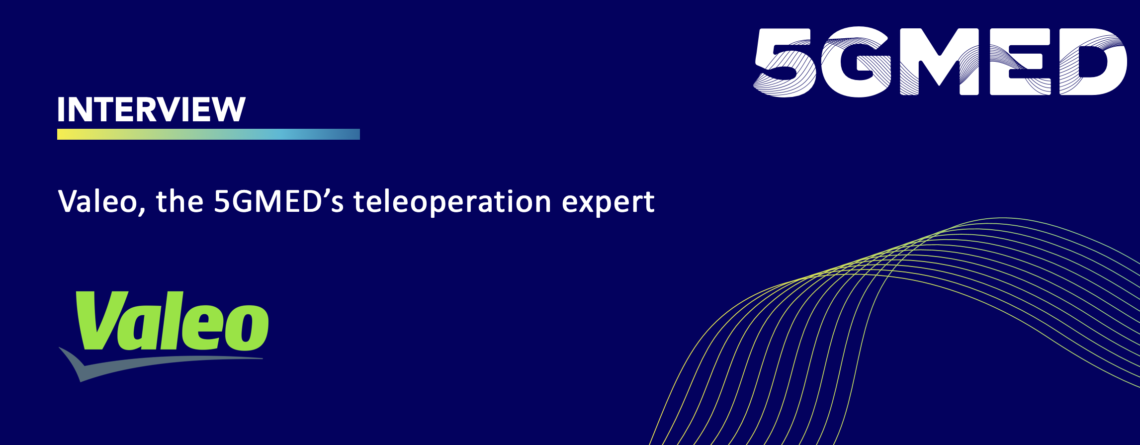Valeo, the 5GMED’s teleoperation expert
Valeo is an automotive supplier, and partner to all automakers worldwide. As a technology company, Valeo proposes innovative products and systems that contribute to the reduction of CO2 emissions and to the development of intuitive driving. In 2020, the Group generated sales of 16.4 billion euros and invested 12% of its original equipment sales in Research and Development. As of December 31, 2020, Valeo had 187 plants, 20 research centers, 43 development centers and 15 distribution platforms, and employed 110,300 people in 33 countries worldwide. Valeo is listed on the Paris Stock Exchange.
What is Valeo doing as Use case 1 (UC1) owner?
The UC1 has to deal with teleoperation via 5G, including cross border situations. UC1 involves AAE, IRT, ARMINES, Vedecom and network partners.
Valeo also has the responsibility to manage the task of “In-car V2X extensions (TCU, sensors, Human-Machine Interfaces)”. We have to carry out the different automotive enablers to make the different use cases happen within the project. Valeo brings an autonomous vehicle level 3 on highways, also useful for UC2.
Define the importance of 5G technologies
From our past experiences with 4G technology, we were able to achieve low-speed teleoperation by fine-tuning the video streams so that they were not too bandwidth-intensive. With the promise of 5G, we hope to be able to increase the speed of teleoperation safely, not be constrained by bandwidth and be able to take advantage of the full capacity of our sensors and have a standardized analysis of the network on which we operate.
Explain the impact of the project in the short term and long term
In the short term, with 5GMED, Valeo wants to demonstrate its ability to deliver this service and explore the possibility of making it a product for our customers in the future. Teleoperation is a way to delay the exit of the Operation Design Domain (ODD) of our automated and connected vehicles.
For the long term, as we have developed on our own the first iteration of teleoperation via 5G, we need to find 5G road authorities partners to create a strong partnership for future potential projects.
What factors ensure safety in Remote Driving?
The most critical part of remote driving is including people in the system. That means the remote driver is legally responsible for the teleoperated people, and the most frustrating part for him is that it happens from several to hundreds of kilometres from him, and it looks like a video game, but it is not.
Considering the human-in-the-loop capacities and limitations, we have to ensure this teleoperation service by implementing a hidden monitoring system in the remote vehicle to trigger the Minimum Risk Maneuver (MRM) in case of inconsistency of the Teleoperation Driving (ToD) instructions or abnormal behaviour received from the remote driver.
The current technologies involved in the teleoperation service also allows us to have a Quality of Service (QoS) prediction on the way ahead. This prediction works on the network, vehicle and remote driver data to assess the possibility of teleoperation in the next kilometres. Valeo has to implement strategies to manage it in real-time for the teleoperation service.
How does Minimum Risk Maneuver (MRM) function in simple words?
The MRM is like a young licensed driver driving for the first time. He will reduce the speed of the vehicle, check twice before doing an action and stop the vehicle if he cannot manage the driving situation.
We know that a human supervisor in the vehicle takes back control when a situation outside the Operation Design Domain (ODD) occurs. Can this be automated with the application of AI in the future?
Nowadays, we are looking for human teleoperation fallback solutions, but in the end, we may have a supercomputer to manage the impaired automated vehicles remotely. It seems science-fiction, but only the initiative will start the development of such a platform when the number of automated vehicles are sufficient to justify it.
What are the possible limitations on the execution of intelligent traffic management? Are there any saturation points regarding the number of vehicles?
The limitations of recommendations are the number of vehicles, the number of instructions, the incoherence between the driving situation and recommendations, the level of autonomy of the vehicle and the ratio between automated and driven vehicles.
What is the minimum number of sensors needed to achieve a road infrastructure close to its optimal functionality?
Data may have to be collected twice. So we recommend covering an area with two sensors and the better is two different sensors. Redundancy on different types of sensors.
What would be the different traffic strategies implemented for this Use Case?
Valeo will receive and contribute to the traffic strategies. We will display them on the onboard Human-Machine Interface (HMI) but not execute them. The execution is not part of 5GMED as planned from the beginning. It would require a UC on its own.
More interviews are available here
Do not miss our next interview, follow us on our social media for more: Linkedin – Twitter.


